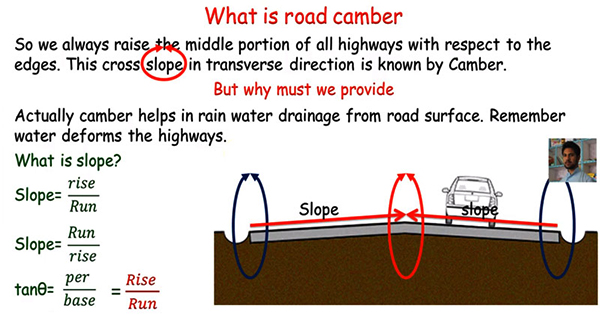Brief overview of camber and it’s types

In this construction video tutorial, you will learn the definition of road camber and it’s types. In all highways, the middle part is raised relating to edges. This cross slope in diagonal direction is called as camber.
Given below the benefits of camber:-
The objective of camber is to drain rain water from road surface in spite of pooling up in the middle of the road.
Safeguard surface specifically for gravel and bituminous roads by venting the unnecessary water instantly.
Safeguard the subgrade by arranging good drainage provisions.
For safety purposes, because wet pavement conditions are not suitable from secured driving point of view.
The cross-section shape of the transverse or cross slope ranges from curved, straight or the combination of both. The middle part of the road that is elevated is known as the crown.
The design values of cambers mostly rely on the type of the pavement as well as on the average amount of the rainfall in the area.Usually, cambers of slope 2 to 3% are arranged.
Following types of cambers are available for the road surface:-
Straight line camber
It is arranged with two equal homogeneous straight line slopes at both sides of the crown and also called as plane cross slopes. They are normally adopted for very flat slopes like PCC or RCC Pavement.
Parabolic Camber
In parabolic camber, the cross slope remains in the shape of simple quadratic parabola. Here, the ordinate Y fluctuates as the square of abscissa X (simple parabola equation).
Parabolic cambers are intended for rapid moving highways. A constructive condition for overtaking operation is arranged because of the curved cross slope. As the slope expands away from the road edge, the flow of surface water outside the pavement is increased.But, it is very difficult to build up parabolic camber.
Composite camber
Composite camber is developed with partially parabola and partially straight line or two straight lines containing various slopes. Usually middle part of the road is prepared as parabolic and arranged with straight slopes near edges. It facilitates to reduce intensity of pressure by escalating the contact area of the wheel.
Video Courtesy : SL Khan

